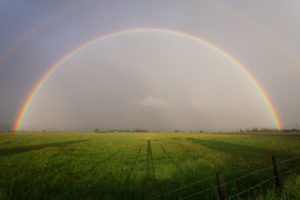
Refraction through water droplets creates these colorful arcs in the sky. Look for them on your next rainy adventure!
Rainbows form when light is refracted—or bent—as it passes through water droplets in the air. To understand how rainbows form, it’s helpful to know a little bit about the properties of light.
Light is a type of electromagnetic radiation that travels through the air as waves. These waves have different wavelengths, which correspond to different colors of light. The shortest wavelengths are violet and blue light, while the longest wavelengths are red and orange light.
When light passes through a medium with a different refractive index, such as water or glass, it is refracted, or bent. This is because the speed of light changes as it passes through different materials.
Now, let’s talk about rainbows. When the sun is shining and there is rain nearby, the water droplets in the air act as tiny prisms that refract the sunlight and create the rainbow. As the light passes through the water droplets, it is refracted and separated into its different colors, creating the characteristic rainbow spectrum of red, orange, yellow, green, blue, indigo, and violet.
The size and shape of the water droplets play a role in the formation of the rainbow. Larger water droplets produce a brighter, more vivid rainbow, while smaller droplets create a softer, more diffuse rainbow.
Rainbows can appear in many different shapes and sizes, depending on the size and shape of the water droplets and the angle of the sunlight. They can appear as circular arcs, partial circles, or even as complete circles if viewed from above.
Rainbows are beautiful and awe-inspiring natural phenomena that occur when the right conditions are present. They are a testament to the complex and fascinating properties of light and the way it interacts with the world around us.
Some Projects to Try at Home
Make a rainbow with a CD: Place a CD in a sunny window and observe the rainbow patterns that appear on the wall or ceiling. This is caused by the refraction of light as it passes through the grooves on the CD.
Create a rainbow with a prism: You can make a rainbow by shining a light through a triangular prism. You can purchase a prism or make one yourself using a piece of clear plastic or glass and carefully cutting it into a triangular shape.
Explore the colors of the rainbow: Mix up a batch of colored water using food coloring or watercolors. Then, fill a clear container with the colored water and place a white piece of paper behind it. Slowly tilt the container and observe how the colors mix and separate as the water flows.
Make a rainbow in a jar: Fill a jar with water and add a few drops of food coloring. Then, hold a flashlight behind the jar and observe the rainbow patterns that appear on the walls of the jar.
Experiment with different shapes and sizes of water droplets: Fill a spray bottle with water and spray it into the air to create different shapes and sizes of water droplets. Observe how the size and shape of the droplets affect the appearance of the rainbow.
Resources for Further Study
Khan Academy: Khan Academy has a series of lessons on light and color that cover the basics of refraction, as well as how rainbows form.
https://www.khanacademy.org/
The Physics Classroom: The Physics Classroom has a lesson on the physics of rainbows that includes interactive simulations and practice problems.
https://www.physicsclassroom.com/
Science Buddies: Science Buddies has a project idea on how to create a rainbow in a jar, which includes step-by-step instructions and a list of materials you’ll need.
https://www.sciencebuddies.org/…/science-class-rainbow…
NOVA: NOVA has a video on their website that explains how rainbows form and how to create your own rainbow using a prism.
https://www.pbs.org/wgbh/nova/
